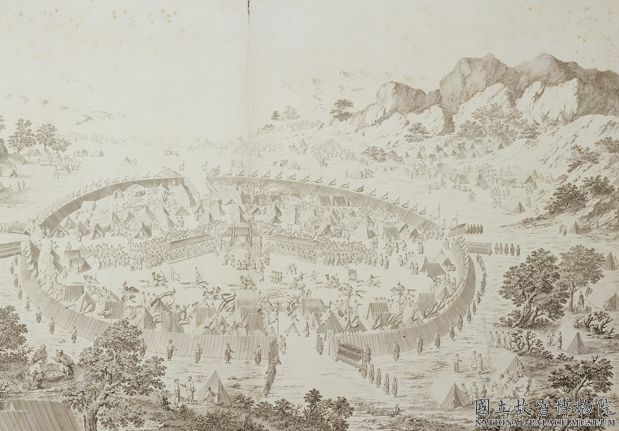[Mingtuo Yugangzhai Postscript “The leading character is from the mountain” Lanting Preface]
Mingtuo Yugangzhai Postscript “The leading character is from the mountain” Lanting Preface, wooden face, folded. Rubbing, 27.9 cm vertically and 27.5 cm horizontally
The third part of Mingtuo’s Yugang Zhai Sutra is stamped with “Cuncheng Hall”, “Yuepo Thatched Cottage”, and “Wei Shaofeng’s approved epigraphy”
The word “collar” in the preface of Lanting, “There are mountains and steep collars here”, can be seen from the copy and engraving that the right army wrote the word “collar”. Song people called the Lanting Rubbings with the word “mountain” on the word “collar” as “collar” from the mountain “Lanting. “The leading character is from Yamamoto” Lanting has many other characteristics, such as: “Lan” has more horizontal lines under the head of the grass, and “sub” has three points. “… The leading words are in the order of the mountain orchid pavilion, and compared with the leading words carved in the Ming and Qing Dynasties, including the yellow silk ink script, they have many similarities, which can be said to be a system. They are obviously different from the Dingwu series (including the so-called Kaihuang orchid pavilion) and the Tang imitations (including the divine dragon and the Tang imitations).”. “There are Yugangzhai Calligraphy, Quicksnow Hall Calligraphy, Zihui Hall Calligraphy, and Yellow Silk Calligraphy in the Lanting. The Yugangzhai Calligraphy is close to the original version, but the copycat has a stiff pen when he draws the line, and also exaggerates the capital weight at the same place, so that people can see the trace of the duplicate model.” (Wang Lianqi’s Research on the Related Issues of the Traveling Xiang Lanting)
Yugangzhai Calligraphy, the Lanting Calligraphy and Zihui Hall Calligraphy Ben Lan Pavilion is different from Ben Lan Pavilion in the “Fast Snow Hall Calligraphy”. The Lanting character in the Yugang Zhai Postscript is fatter than that in the Zihui Hall Ink Treasure. It belongs to a better version. The inscriptions and inscriptions of the Orchid Pavilion in Yu Gang Zhai Postscript are the same as those of the Orchid Pavilion in Zi Hui Tang Ink Treasure, including those of Fan Zhongyan, Wang Yaochen, Mi Fu and Mi Youren; “Yu Gang Zhai Postscript” This Orchid Pavilion and the postscript of Zhang Cheng in the Western Qin Dynasty; However, the typography and calligraphy style of the two books are not exactly the same. “Yu Gang Zhai Postscript” in this Lanting has more than one horizontal character for “Lan” and three points for “Ci”. There are “Inner Hall Secretary’s Seal”, “Mi Fu” and other seals
The Yugangzhai Sutra, ten volumes, was carved in the thirty-ninth year of the Wanli period of the Ming Dynasty (1611 AD). Edited by Wang Kentang (with the name of Yutai, the name of Daman Nunnery, from Jintan, Jiangsu Province), engraved by Guan Siqing. The title of the seal book is “Yugangzhai’s best ink”, and the last seal book is “Wang’s imitation of the stone on the altar of the five gold in the summer of 1911 at the age of thirty-nine years of Wanli (1611)”, which is based on the famous calligraphic works of Wei, Jin, Tang and Song. After Wang bought the Chinese “True Appreciation of Zhai” and carved the wood after the fire, he inserted it in the card. The original card was half wood and half stone. This inscription remains in the early Qing Dynasty
![图片[1]-Preface to Lanting in Yugang Zhai Calligraphy by Ming Tuo-China Archive](https://chinaarchive.net/Ming dynasty/Inscription/55043[1024].jpg)
![册页1 图片[2]-Preface to Lanting in Yugang Zhai Calligraphy by Ming Tuo-China Archive](https://chinaarchive.net/Ming dynasty/Inscription/55042[1024].jpg) 册页1
册页1![册页2 图片[3]-Preface to Lanting in Yugang Zhai Calligraphy by Ming Tuo-China Archive](https://chinaarchive.net/Ming dynasty/Inscription/55041[1024].jpg) 册页2
册页2![册页3 图片[4]-Preface to Lanting in Yugang Zhai Calligraphy by Ming Tuo-China Archive](https://chinaarchive.net/Ming dynasty/Inscription/55040[1024].jpg) 册页3
册页3![册页4 图片[5]-Preface to Lanting in Yugang Zhai Calligraphy by Ming Tuo-China Archive](https://chinaarchive.net/Ming dynasty/Inscription/55039[1024].jpg) 册页4
册页4![册页5 图片[6]-Preface to Lanting in Yugang Zhai Calligraphy by Ming Tuo-China Archive](https://chinaarchive.net/Ming dynasty/Inscription/55038[1024].jpg) 册页5
册页5![册页6 图片[7]-Preface to Lanting in Yugang Zhai Calligraphy by Ming Tuo-China Archive](https://chinaarchive.net/Ming dynasty/Inscription/55037[1024].jpg) 册页6
册页6![册页7 图片[8]-Preface to Lanting in Yugang Zhai Calligraphy by Ming Tuo-China Archive](https://chinaarchive.net/Ming dynasty/Inscription/55036[1024].jpg) 册页7
册页7![册页8 图片[9]-Preface to Lanting in Yugang Zhai Calligraphy by Ming Tuo-China Archive](https://chinaarchive.net/Ming dynasty/Inscription/55035[1024].jpg) 册页8
册页8![册页9 图片[10]-Preface to Lanting in Yugang Zhai Calligraphy by Ming Tuo-China Archive](https://chinaarchive.net/Ming dynasty/Inscription/55034[1024].jpg) 册页9
册页9![册页10 图片[11]-Preface to Lanting in Yugang Zhai Calligraphy by Ming Tuo-China Archive](https://chinaarchive.net/Ming dynasty/Inscription/55033[1024].jpg) 册页10
册页10![册页11 图片[12]-Preface to Lanting in Yugang Zhai Calligraphy by Ming Tuo-China Archive](https://chinaarchive.net/Ming dynasty/Inscription/55032[1024].jpg) 册页11
册页11![册页12 图片[13]-Preface to Lanting in Yugang Zhai Calligraphy by Ming Tuo-China Archive](https://chinaarchive.net/Ming dynasty/Inscription/55031[1024].jpg) 册页12
册页12![册页13 图片[14]-Preface to Lanting in Yugang Zhai Calligraphy by Ming Tuo-China Archive](https://chinaarchive.net/Ming dynasty/Inscription/55030[1024].jpg) 册页13
册页13![册页14 图片[15]-Preface to Lanting in Yugang Zhai Calligraphy by Ming Tuo-China Archive](https://chinaarchive.net/Ming dynasty/Inscription/55029[1024].jpg) 册页14
册页14


![[Qing Dynasty] British female painter—Elizabeth Keith, using woodblock prints to record China from the late Qing Dynasty to the early Republic of China—1915-China Archive](https://chinaarchive.net/wp-content/uploads/2022/11/image-191x300.png)


